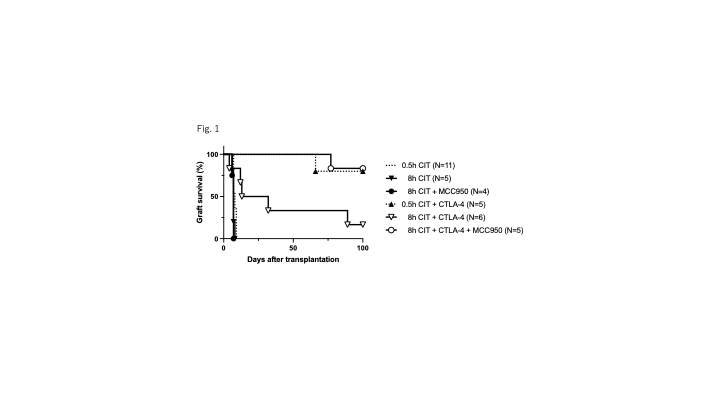NLRP3 inhibition prevented graft infiltration of inflammatory macrophages leading to long-term graft acceptance in mouse heart transplantation
Takuya Harada1, Ryoichi Goto1, Yoshikazu Ganchiku1, Agustina Forgioni1, Takuji Ota1, Norio Kawamura2, Masaaki Watanabe2, Masaaki Zaitsu1, Moto Fukai1, Tsuyoshi Shimamura3, Akinobu Taketomi1,2.
1Gastroenterological Surgery I, Hokkaido University, Sapporo, Japan; 2Transplant Surgery, Hokkaido University, Sapporo, Japan; 3Division of Organ Transplantation, Hokkaido University Hospital, Sapporo, Japan
Background: Inflammasome complexes including NLRP3 play a central role in ischemia-reperfusion injury in transplantation. Aim. To examine the impact of NLRP3 inhibitior on graft preservation and allo-immune responses in organ transplantation. Methods. BALB/c mice were transplanted with C57BL/6 (B6) cardiac allografts. Grafts were stored for 0.5 h or 8 h cold ischemia time (CIT) in heparin saline solution (1%) with or without NLRP3 inhibitor, MCC950 (400 nM). Mice were given 250 μg of CTLA-4 Ig intraperitoneally on day 2 post-transplantation. IFNg-ELIspot assays were performed using splenocytes obtained from mice on day 2 and 10 post-transplantation after coculturing with irradiated donor-strain splenocytes for 24 h.
Results: Almost all B6 cardiac allografts were well-functioning when transplanted into BALB/c mice immediately after harvesting (0.5 h CIT). Meanwhile, 30% of primary graft non-function was observed after 8 h CIT (n=20, *P=0.027 vs. 0.5h). Treatment with MCC950 during 8 h CIT significantly reduced incidence of primary non-function (n=25, 4.2%, *P=0.0353). Nonetheless, MCC950 during cold preservation alone had no effect on the survival time of allograft (solid circles and solid line, Fig. 1). The CTLA-4 Ig treatment on day 2 posttransplantation efficiently prolonged 4 of 5 B6 allografts survival time >100 days in 0.5 h CIT (solid triangles and dotted line, Fig. 1) but not in 8 h CIT (MST=22.5 days, n=6, empty inverted triangles and solid line, Fig. 1).

Of note, addition of MCC950 during 8 h CIT together with CTLA-4 Ig treatment on day 2 posttransplantation significantly prolonged a graft survival time (empty circles and solid line, Fig. 1).
A significant lower IFNg production of splenocytes obtained from BALB/c mice treated with CTLA-4 Ig on day 10 post-transplantation was observed when allografts were treated with MCC950 during 8 h CIT (Fig. 2).

In addition, MCC950 significantly inhibited graft infiltration of CD11bhigh F4/80+ macrophages with inflammatory phenotype; CCR2+ CD86+ Ly6C+ MHC class II- on day 2 post-transplantation (Fig. 3). Furthermore, the inhibition of graft infiltration of inflammatory macrophages by anti-CCR2 antagonist significantly prolonged graft survival time in 8 h CIT (4 of 5 allografts survival time >100 days, n=5, *P=0.0316 vs. untreated 8 h CIT).
Conclusion: Inhibition of NLRP3 activation of the graft with prolonged CIT prevented inflammatory macrophages infiltration into the graft leading to long-term graft acceptance. It could be a promising treatment strategy for inducing an immune tolerance in organ transplantation.
[1] cold ischemic time
[2] mouse cardiac transplantation
[3] CTLA4-Ig
